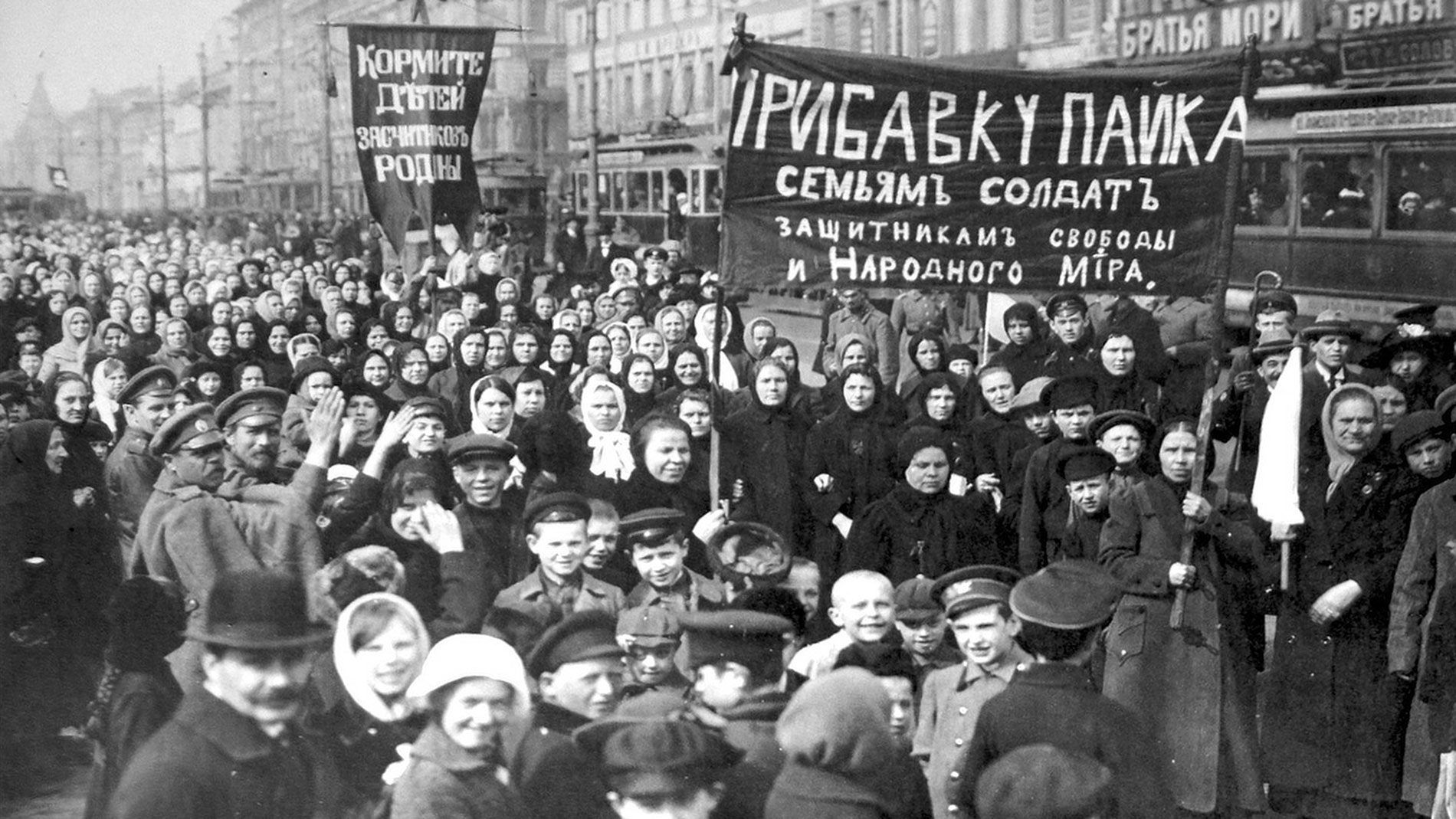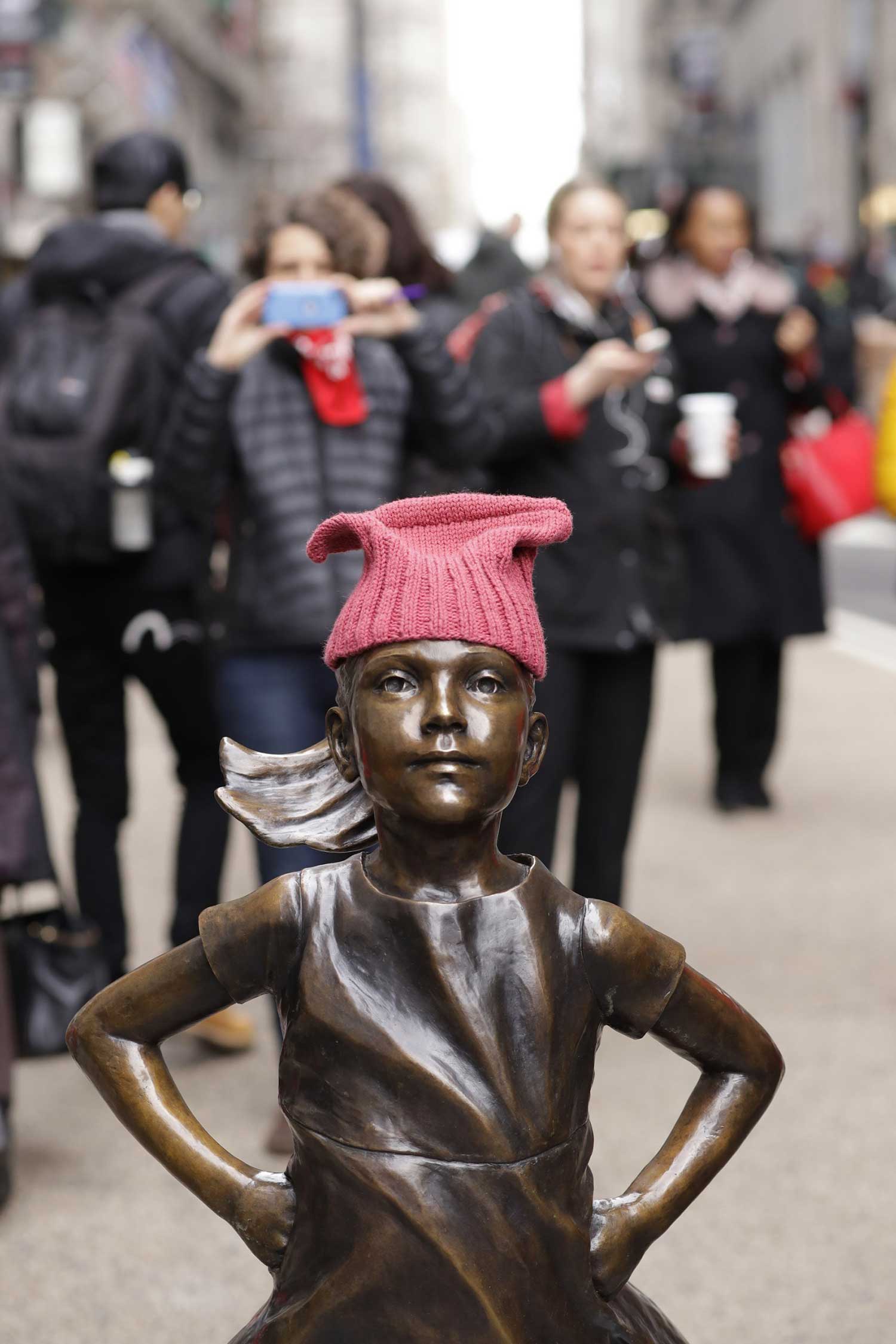It is easy to guess the answer that the USA Today Network was fishing for when it asked, “Will the Women's March fizzle out like Occupy Wall Street?”; will it “translate into anything, or will it just be a feel-good event for the yoga pants and crunchy granola set?” But knowing the answer makes it no less dispiriting. The pattern is familiar:
March 8, 1917: International Women’s Day is officially instituted in response to women taking to the streets of Petrograd and launching the Russian Revolution by making concrete economic demands to the state.
March 8, 2017: International Women’s Day is commemorated in the streets of New York with women fawning over an advertisement for a $2.5 trillion asset management firm by, among other things, adorning it with the “pink pussy hat” that, only six weeks earlier, had stood for a vague amalgam of social and cultural demands addressed to the state.
The plaque accompanying the statue-advertisement “Fearless Girl” commissioned by the McCann New York advertising agency for its client State Street Global Advisors sums up this predictable if historic transition in a phrase: “SHE makes a difference.” “SHE” is the ticker symbol for State Street Global’s exchange-traded fund that tracks companies that have higher levels of gender diversity in their leadership. The conceit of the fearless girl with hands on hips, chest pushed out, leaning in and staring down her predecessor statue-advertisement, Arturo Di Modica's testosteronic “Charging Bull,” is that she is David to the Bull’s Goliath and feminist to Wall Street’s boys club. State Street Global’s SHE, we are to understand, is her sling. But of course that is just the conceit—the real message is that she the girl and SHE the commodity are one and the same.
Like the longstanding association of women and things, the alliance between feminism and Wall Street is not new. Facebook COO Sheryl Sandberg’s 2013 Lean In: Women, Work, and the Will to Lead and its accompanying manufactured “movement” can stand well enough for the alliance’s contemporary doctrine: that women can exploit women and other vulnerable groups as well as or better than men if they lean in, shift their feelings from she to SHE and identify with the will and thrill of violent expropriation. Investing in Wall Street, we are told by State Street Global and McCann New York, might effectively reverse the course of the election—but it takes only a little reflection to realize that it is exactly this pattern of thought that lost it for us. Bernie Sanders and Donald Trump both challenged this argument during the presidential campaign—“oligarchy” faded as “crooked Hillary” rose to the top but both phrases grabbed the electorate more effectively than “grab ‘em by the pussy.” Once the momentary presumption that the reveal would hurt his campaign rather than help it dissolved, Trump’s unguarded comment came to be less about boorish behavior or criminal molestation and more like another version of “lean in” or the murderous structural violence of the billionaire set, its wannabes and their unhinging of the economy of things. After all, the election was about identity politics of gender, race and nation that—for a fleeting moment—revealed their true stripes to be about class. Nancy Fraser put it this way:
Those who voted for Trump, like those who voted for Brexit and against the Italian reforms, have risen up against their political masters. Thumbing their noses at party establishments, they have repudiated the system that has eroded their living conditions for the last thirty years. The surprise is not that they have done so, but that it took them so long.
The “system” of our “political masters” and “party establishments” that Trump’s working-class constituents voted against was not simply social liberalism or economic neoliberalism but instead their merger. “Progressive neoliberalism,” Fraser calls it. It is an alliance between “mainstream currents of new social movements (feminism, anti-racism, multiculturalism, and LGBTQ rights), on the one side, and high-end ‘symbolic’ and service-based business sectors (Wall Street, Silicon Valley, and Hollywood), on the other.” For all intents and purposes, in other words, the once oppositional new social movements have come to be perceived as the baroque courtly style and pious churchly moralism of the ruling class.
That style and moralism was what the epithet “crooked Hillary” stood for before the election just as it is what “Fearless Girl” resuscitates after. Of course, the Trump regime is more Wall Street than even Hillary’s was ever likely to have been and it comes complete with its own fearless girl in the figure of Ivanka. The pattern is familiar because it adopts the pose of loyal opposition that is the governing illiberal conceit of liberalism: as Ivanka is to Trump, so “Fearless Girl” is to “Raging Bull,” so feminism is to Wall Street, so the comforts of identity are to the violence of class. Regardless of whether it is cynical and opportunistic or muddled and weak it is this pas de deux—not Trump or Wall Street on their own—that saps the courage and promise from the fading memory of the women who marched on Petrograd 100 years ago.
Feminists like us have little immediate say over the economic and political violence at the disposal of our rulers but we do have some say over the cultural form that feminism assumes today. “No theory today escapes the marketplace,” Theodor Adorno famously observed already in 1966. Understanding how the best of our intentions and most well-meaning of our identifications have been turned into the cruelest of weapons against us would be a good place to start.






